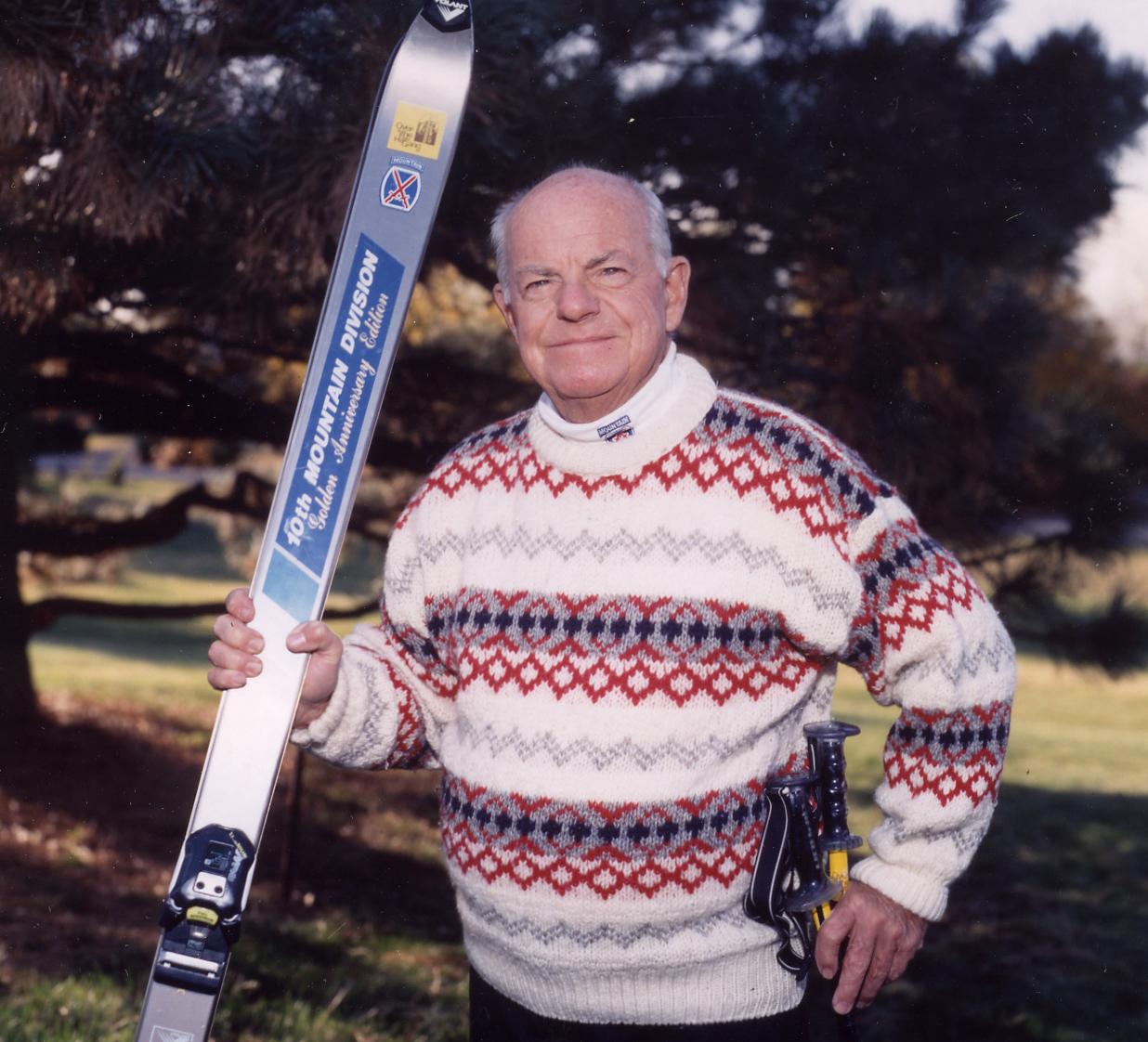
Earl Ervin Clark, who served in the 10th Mountain Division in World War II, died Sunday at his Littleton home at age 95.
The 10th Mountain Division is famous for its role in driving Axis troops from the mountains of northern Italy in 1945, thus helping end the war. The soldiers lived and trained at Camp Hale in the Rockies, and after the war some of them returned to Colorado to play a key role in the launch of the ski industry.
In 2003, CPR’s Dan Drayer interviewed Clark when a 10th Mountain Division exhibit was at Boulder History Museum.
On the primitive skis of the 1940s:
“They were an entirely different breed, as you can imagine. The skis the army provided for us were either 7-foot or 7-foot-6-inch long, made of hickory. The original skis didn’t even have metal edges, but they corrected that. They served their purpose.”
On Camp Hale, where ski soldiers were trained:
“Camp Hale was selected because it had a railroad, the DNRG climbing Tennessee Pass. It was at 9,200 feet, which gave us six-month winters. The valley was big enough to build a camp that could be capable of housing 18,000 people, which, incidentally was done as the snow melted in the spring of 1942. Thousands of workmen showed up to work there to build this camp. And by November, it was completed. In the intervening months, they continued to recruit skiers and mountaineers. But because they were bringing in horses and mules, they had to recruit very heavily in the West. Out of the Ivy League skiers in the East, all of a sudden came cowboys and mule skinners Texas, Wyoming, Montana. You had two entirely different cultures showing up.”
On the heavy packs they carried:
“[They were] much too heavy. I weighed 118 pounds and with a full field pack I couldn’t hardly lift it off the floor, much less carry it. But that’s because everything was an experiment. The things we got initially up there weighed too much. ... We even had a song about 90 pounds of rucksack. But as timed passed along we learned what we could discard and what we didn’t have to carry with us to survive at high elevations in the winter time. And the pack finally got down to a sensible weight.”
On how he nearly died:
“In 1943, the 87th, which was the original regiment that I joined, was pulled out of Camp Hale very suddenly and sent to California for amphibious by the Marine Corps to land on the island of Kiska in the Aleutian Islands. The Japanese had occupied the Aleutian chain since the year before, Kiska and Attu. And because it was American soil, [President Franklin D.] Roosevelt ordered the islands be taken back. Attu was taken in May of 1943 with very, very heavy casualties because the Japanese occupied all of the high ground. So the 87th, being a mountain trained unit, was sent into Kiska to take the high ground. Fortunately, for all of us, a brilliant naval maneuver on behalf of a Japanese admiral took place and he slipped some cruisers into the island and was able to evacuate their entire garrison. And those who, feeling they could not be rescued, made a suicide oath. So I’m alive probably because of that incident.”
On the 10th Mountain Division’s role in the ski industry:
“Skiing had not developed in the United States, really. It was still primarily a European sport. In the 1930s, the Ivy League universities of New England began to recruit ski coaches and instructors from Europe, many of them Austrians and Germans and a few Italians and Swiss. So it was beginning. The big ski area that had been opened at that time was Sun Valley in Idaho and Lake Placid in New York. So it was really the 10th Mountain Division and the thousands of men that were in it that became the fathers of the ski industry after the war.
“The first [ski area] that was built right after the war was the Arapahoe Basin by a 10th Mountain Division man named Larry Jump. Then three more: an Austrian, John Litchfield of Dartmouth, Percy Rideout of Dartmouth, and Friedl Pfeifer put Aspen together. And you can take what happened in our industry here in Colorado and place it all over the United States, because 64 ski areas were started by or operated by the men of the 10th after World War II.”
In 2007, Ryan Warner interviewed Clark as the WW II vets from the 10th Mountain Division National Association held their last reunion.
On growing older and the last reunion:
"It became apparent on a reunion in Europe last summer that age was taking its toll and that we probably had reached the point where we should gather the group for the last time. We had an association at one time of about 5,500. To the best of our knowledge now we are below 1,600.
“Not only the rather remarkable war experience for the men of the 10th Mountain, but we feel that the life that was lead after the war, the great common love of the mountains of so many men, was the glue that held the group together.
“All of us are old men, bottom line. I’m 88. Of course there is considerable sadness to see people that we’ve known for 60-plus years after the end of the war. Now as we lose men, we’re not just losing men of the 10th Mountain Division, we’re losing very very close friends.”








